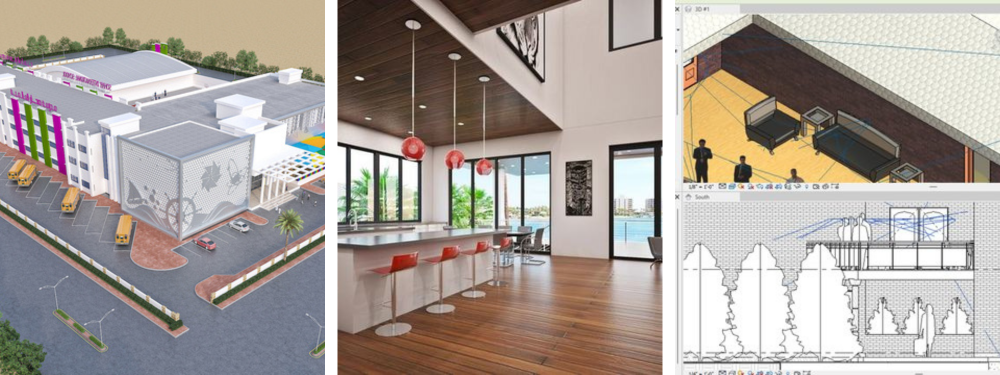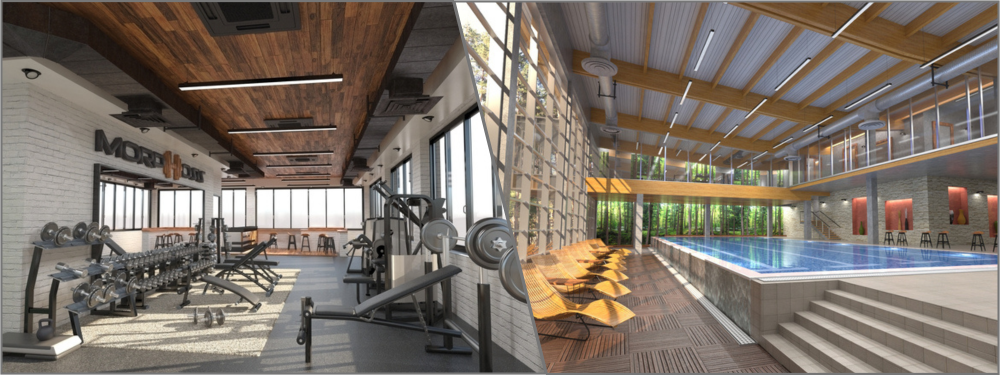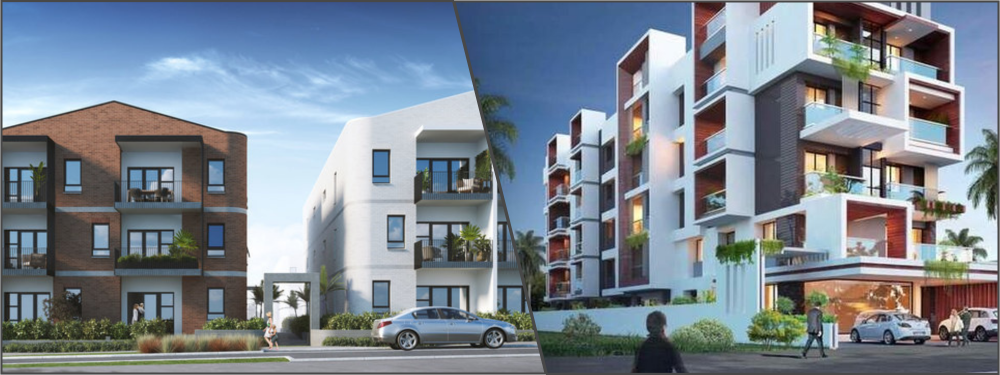Architectural visualizations come in several different types. A Static 3D rendering is the most basic form, whereas VR/AR format sits at the top of the range regarding sophistication and cost. The 3D video animation options are the 3D walkthrough or 3D flythrough. All are products of CGI (computer-generated imagery), meaning the image and video do not require physical buildings to create.
CGI in the architectural industry is mainly used for marketing purposes, including client presentations. In this case, 3D animation services designers use computer software to draw hyper-realistic images of architectural concepts based on construction drawings or even architects’ simple sketches. Thanks to their lifelike quality, the images are expected to help architects secure private/public contracts, secure findings, or make property pre-sales.
 Table of Contents
Table of Contents
RELATED: 3D flythrough & 3D architectural animations, costs, rates, and pricing for companies
3D flythrough and 3D walkthrough
Both types of 3D video animation are technically the same; the only difference is the content or scope of focus. A 3D flythrough focuses on the exterior and the surrounding area of a particular building, while a 3D walkthrough highlights the interior elements.
A dynamic 3D flythrough starts from a vantage point, providing a broad perspective of the building. The camera gradually glides closer, revealing surrounding elements such as public amenities, gardens, parks, highways, and traffic flow. As the camera zooms in, the building’s exterior captivate viewers with striking features like elegant terraces, driveways, pools, and architectural style, all masterfully presented in the flythrough.
A 3D walkthrough uses the same technique, but viewers are spoiled with an interior design presentation, and everything from room layout to decorations and lighting fixtures to kitchen countertops is covered. A 3D walkthrough may seem more limited than a 3D flythrough, but both are essential depending on the purpose. For example, 3D flythrough design services are more appropriate for large-scale residential development, while a walkthrough is best to showcase a renovation project.
RELATED: Why you should hire a 3D walkthrough animation service for your architectural project

Why 3D flythroughs and 3D walkthroughs are popular
A significant benefit for clients is that 3D flythroughs and 3D walkthroughs, created using 3D architectural visualization services, allow them to see the complete picture of a project, even during a concept phase. In addition to having a detailed overview of the design, they can provide feedback more efficiently. The following advantages make 3D flythroughs and 3D walkthroughs a popular architectural visualization option favored by architects and clients.
Visual impact enhancement
Architectural 3D walkthroughs and 3D flythroughs help capture every aspect of a proposed building in detail. Their hyper-realistic visuals deliver a true-to-life representation of any given concept in a format that clients can easily understand. The vivid imagery of a building’s styles, features, and other beneficial elements trigger a solid visual impact to catch viewers’ attention.
During the animation, viewers are expected to develop a sense of being “in and around” the building. The dynamics between scene progressions should make the audience feel like they are holding the camera and navigating the building. 3D flythrough designers often use background sounds to enhance the impact even further to an emotional level. 3D walkthrough animation designers bring viewers inside the building, and an effective 3D flythrough blends them with the neighborhood.
RELATED: Leveraging 3D architectural animation to attract new clients in real estate
Better Understanding
While necessary for construction design services, two-dimensional construction drawings can be too technical for a typical client. Even when using static 3D renders, some clients still have difficulties seeing the bigger picture. On the other hand, an architectural 3D walkthrough, facilitated by construction design services, allows one to explore the building from a real point of view. The visuals represent everything clients can expect to see as they enter the door and explore the interior.
The same thing applies to a 3D flythrough design. Although the viewing angle (usually a bird’s eye perspective) is not at a natural eye level, an animation presented from an aerial perspective should give a clear overview of everything around the building. A panoramic view of a property helps stimulate a client’s desire to live in the neighborhood; in other words, it improves the chances of making a sale.
Online and Offline Channels
Offline marketing efforts that utilize digital billboards and broadcast advertising to showcase property 3D walkthroughs and 3D flythroughs can be highly effective for real estate developers. However, the downside to these marketing methods is the cost. Securing slots for TV commercials and renting digital billboards can be expensive, making them significant investments in advertising and promotion.
3D architectural animation comes in standard video formats, playable on almost every website browser, mobile phone, and social media. Marketers can play a 3D walkthrough and 3D flythrough at a low cost on popular online platforms, including video-sharing sites.
Since people spend many hours each day online, 3D animation can be an affordable long-term investment to boost sales. Furthermore, the audience can easily share the video links with friends and followers with just a few clicks. Never underestimate the power of social media exposure and marketing.
RELATED: How to create a virtual tour of homes with 3D rendering services

Sense of Reality
Freelance 3D virtual reality & VR/AR rendering services provide the formats of choice to deliver an architectural presentation as close to reality as possible. 3D VR/AR’s interactive nature results in an immersive experience, allowing clients to become integral parts of the digital world projected around them. A potential hurdle to creating such content is price. 3D animations like a 3D flythrough and 3D walkthrough might not have the benefit of interactivity, but they are the next best thing without breaking the bank.
3D animation provides a realistic first-person point of view (POV), achieved through the design work of 3D animation designers. Unlike news reports, 3D walkthroughs and flythroughs serve as tour guides, leading viewers through the exploration of a building. The primary goal is to help viewers understand the spatial layout and overall design.
RELATED: Architectural VR/AR 3D rendering costs, rates & 3D modeling pricing for design firms
Contextual Elements
Meaningful details like ornaments on the wall, specific furniture styles, paintings, toys, and decorations are contextual elements that evoke emotional connections. Every object – to which the viewers can relate – builds a comfortable atmosphere, like home. The moment they see something familiar in the visualization, they imagine living inside the building. Clients begin to picture themselves surrounded by all the contextual elements presented in every scene.
In architectural visualization, an object exists to fill an empty room and trigger viewers’ positive emotional experience with the building. With 3D visualization services, a 3D flythrough can focus on the exterior, incorporating various contextual elements such as vehicles, traffic lights, and natural objects. Even a familiar sight of everyday activity can bring a client closer to the purchase decision.
More Conversions Rate
On average, video content keeps visitors on a website for up to 10 times longer than on a text-only page. A standard guideline applies to web pages, including property listings. A visitor’s time on a page increases the likelihood of conversion marketing. While a more prolonged duration does not necessarily mean a sale, at least it gives the visitor a better possibility of searching for further information about the video or the content.
A realtor’s site with a 3D walkthrough or flythrough effectively converts prospects to leads. When posted on social media platforms like YouTube, Instagram, Facebook, or Twitter, the video gains wider exposure, driving traffic to the listing page. Online videos offer 24/7 accessibility, enabling prospective buyers to inspect details at their convenience. Moreover, always accessible 3D walkthroughs and flythroughs allow thorough previews, giving buyers confidence before investing.
The architectural industry is a fiercely competitive business. Architectural 3D visualization (animation) is the best format to help you stand out. As for the cost, about 80% of 3D architectural visualization services charge between $500 and $1,500 for a static render completed in 3-4 days. An animated 3D walkthrough or 3D flythrough costs around $2,500 per minute, done over approximately two weeks.
| Architectural 3D Rendering Type | Price Range | Duration |
|---|---|---|
| Static Render | $300 – $1,000 | 3 to 4 days |
| Animated 3D Flythrough or 3D Walkthrough | Around $2,500/min | Approx. 2 weeks |
The approximate prices and durations may vary based on specific projects and service providers.
RELATED: What are architectural 3D visualization costs, service fees & rates for companies?

Better Opportunities
Leveraging architectural 3D flythrough and 3D walkthrough services opens up many opportunities to build a distinguished portfolio, showcasing intricately detailed and captivating visualizations of architectural projects. Among the most notable benefits are the following:
- Visualizing Projects Pre-Construction: With cutting-edge CGI technology, architects can present realistic representations of architectural concepts that have yet to be realized. This capability allows architectural design experts to showcase their unconventional design approaches and distinctive styles to potential clients and stakeholders.
- Emphasizing the Best Elements: 3D flythrough designers craft videos based on construction plans, employing visualization styles that accentuate the project’s most striking features. Artful scene transitions and visual effects enhance the presentation’s appeal.
- Encouraging Client Collaboration: 3D animation services allow clients to request modifications before construction commences, facilitating cost-effective and transparent communication between client and architect regarding building details.
- Providing Comprehensive Perspectives: While static renders offer photorealistic snapshots of a building, 3D animations elevate the experience by providing a 360-degree property tour. This immersive approach gives viewers a deeper understanding of the architects’ design philosophy and leaves a lasting impression.
RELATED: How 3D virtual reality is changing the real estate industry
Summary
3D flythrough and 3D walkthrough services provide architects and real estate developers with a competitive edge by enabling hyper-realistic visualizations of architectural concepts. These immersive visual tours showcase exterior and interior designs, even before construction. Benefits include visualizing projects pre-construction, highlighting key design features, encouraging client collaboration, and offering comprehensive perspectives.
3D animations are also valuable in online and offline marketing, maximizing exposure and increasing conversion rates. Costs for these services vary, with static renders typically ranging from $300 to $1,000 (completed in 3 to 4 days) and animated 3D flythroughs or walkthroughs costing around $2,500 per minute (completed in approximately two weeks).
Cad Crowd connects you with skilled 3D visualization experts to meet your project needs. Explore the advantages of 3D flythrough and 3D walkthrough services for your architectural projects by requesting a free quote from Cad Crowd.
